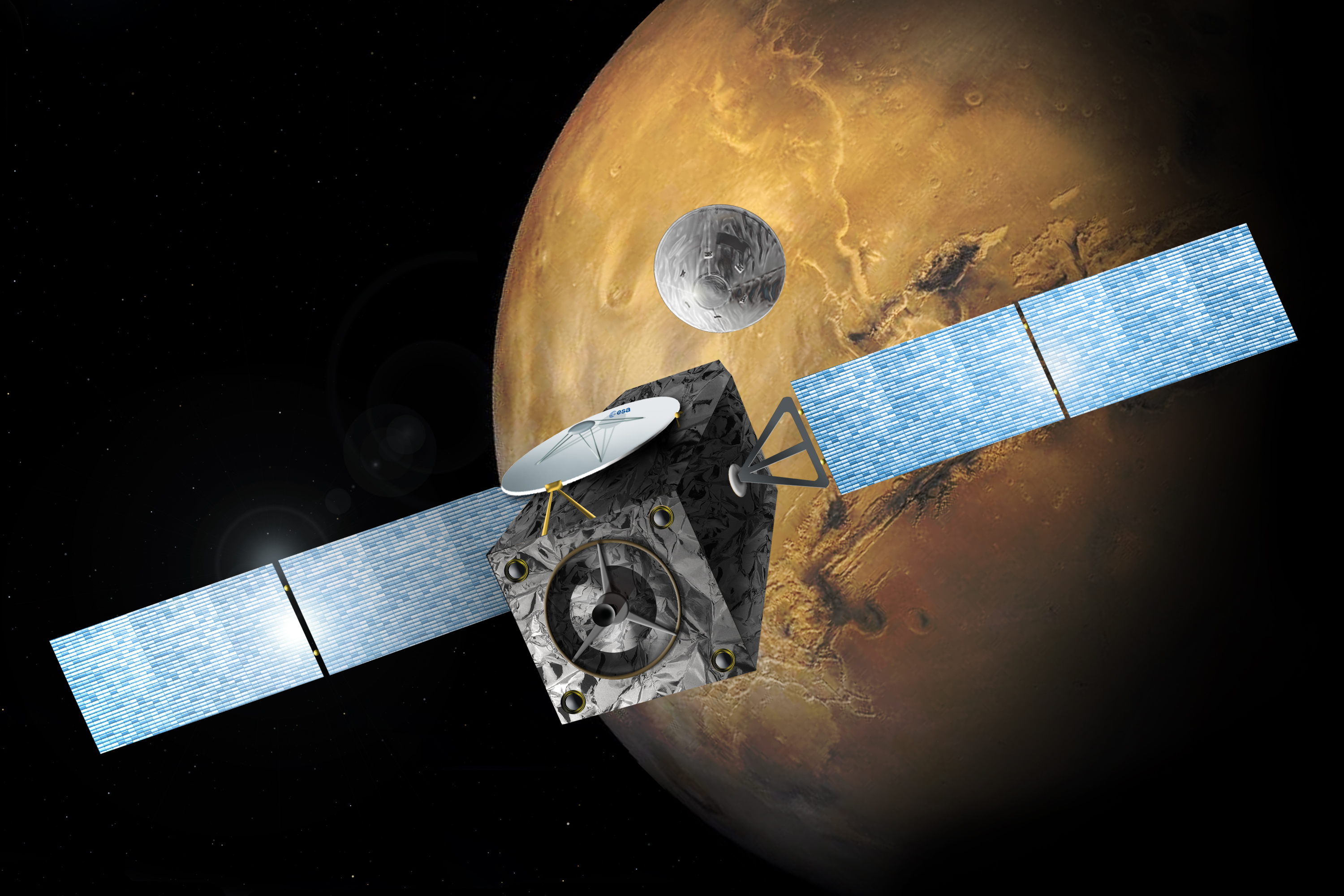ExoMars 2016 (TGO and EDM) - PSA
Exobiology on Mars 2016

ExoMars 2016 is an ESA and Roscosmos mission to Mars launched on 14 March 2016. It is the first mission of the ExoMars programme and has the objective of searching for evidence of methane and other trace gases in the martian atmosphere which may be signatures of active biological or geological processes. The ExoMars 2016 Trace Gas Orbiter will also be used as a relay platform for the ExoMars RSP (Rover and Surface Platform) mission and other missions as required. The mission also has the objective of demonstrating landing technologies in preparation for the RSP mission.
ExoMars 2016 will arrive at Mars in October 2016. The lander Schiaparelli is due to touchdown on October 19th 2016. Following this the Trace Gas Orbiter will spend three months in an elliptical orbit of Mars before gradually aerobraking to its 400 Km circular science orbit. It is due to reach the science orbit in late 2017 after which it is planned to spend one Mars year in science operations.
Trace Gas Orbiter Instruments
ACSAtmospheric Chemistry Suite ACS is a set of three spectrometers ranging from near to mid-infrared, which will measure the spectrum of the water, methane and a variety of minor atmospheric constituents. It is capable of operating in solar occultation mode, nadir mode and limb mode. No public data available yet |
CaSSISColour and Stereo Surface Imaging System
CaSSIS is a high resolution imager (5 metres per pixel) capable of obtaining colour and stereo images over a wide swathe. CaSSIS will provide the geological and dynamical context for sources or sinks of trace gasses detected by ACS and NOMAD.
Raw data is produced daily and is made public after 6 months. Calibrated data is delivered by the CaSSIS team on a rolling one month basis six months after observations are made. Currently, as deliveries only started for science phase in Spring 2020 the calibrated data will lag the operational six month baseline for a few months until the deliveries catch up. Latest news on the delivery status and known issues can be found here. |
FRENDFine Resolution Epithermal Neutron Detector FREND will map hydrogen from the surface down to a metre deep to determine the concentration of water ice near the surface with a pixel size corresponding to 40Km on the Martian surface. The instrument also includes a dosimetry module which will constantly monitor the radiation environment in orbit around the planet. No public data available yet |
NOMADNadir and Occultation for MArs Discovery
NOMAD is a combination of three spectrometers, two infrared and one ultraviolet. It is designed to perfom high sensitivity orbital identification of atmospheric components. It is capable of operating in solar occultation mode, nadir mode and limb mode.
|
|
|
ScHiaparelli Investigations
AMELIAAtmospheric Mars Entry and Landing Investigation
The Schiaparelli Entry and Descent Science Team will carry out a programme to determine atmospheric conditions such as density and wind from a high altitude to the surface. The AMELIA investigation will use Schiaparelli's engineering data taken during the descent for this purpose and will be one of very few in-situ data sets taken as a lander passes through the Martial atmosphere.
No public data available yet |
COMARS+Combined Aerothermal and Radiometer Sensors Instrument Package
The COMARS+ package consists of a set of three small (22 mm diameter) combined sensors spaced equally across the rear cover of Schiaparelli plus a broadband radiometer and an electronics box. These sensors will monitor the pressure on the back cover, its surface temperature, the total heat flux rate and the radiative heat flux. These measurements have the engineering goal of providing an understanding of Schiaparelli's performance and will also contribute towards the AMELIA science goals. The measurements will begin outside the atmosphere and will be performed until the back cover separates at an altitude of around 1200 metres.
No public data available yet
|
DeCaDescent Camera
The descent camera will be used to image the Martian surface as Schiaparelli approaches the landing site to determine the transparency of the Martian atmosphere and to support the generation of a 3-D topographic model of the surface at the landing site. DeCa will start taking images shortly after the front-shield of Schiaparelli has been jettisoned at an altitude of around 7 Km. It will take 15 images at 1.5 second intervals.
No public data available yet |
DREAMSDust characterisation Risk assessment and Environment Analyser on the Martian Surface The DREAMS surface package consists of a suite of sensors to measure the wind speed and direction (MetWind), humidity (DREAMS-H), pressure (DREAMS-P), atmospheric temperature close to the surface (MarsTem), the transparency of the atmosphere (Solar Irradiance Sensor, SIS) and atmospheric electrification (Atmospheric Radiation and Electricity Sensor, MicroARES). No public data available yet |
Data Access
SEARCH INTERFACE
Browse FTP
PSA FTP Site including Exomars 2016 spacecraft HK and reference files
Trace Gas Orbiter Data
- ACS
- CaSSIS
- FREND
- NOMAD
Entry Descent and Landing Data
- AMELIA
- COMARS+
- DeCa
- DREAMS
